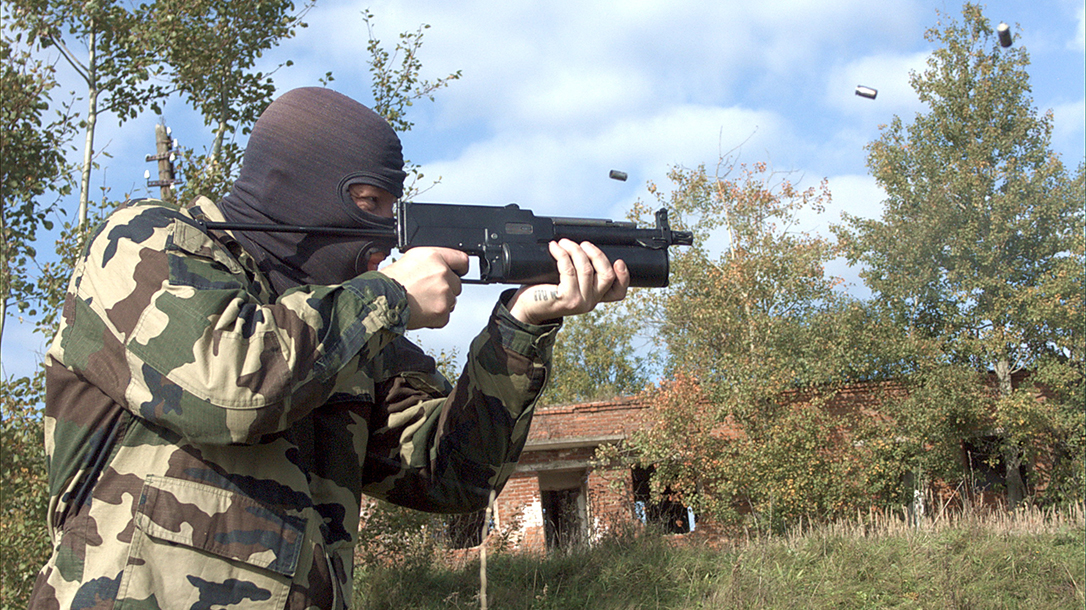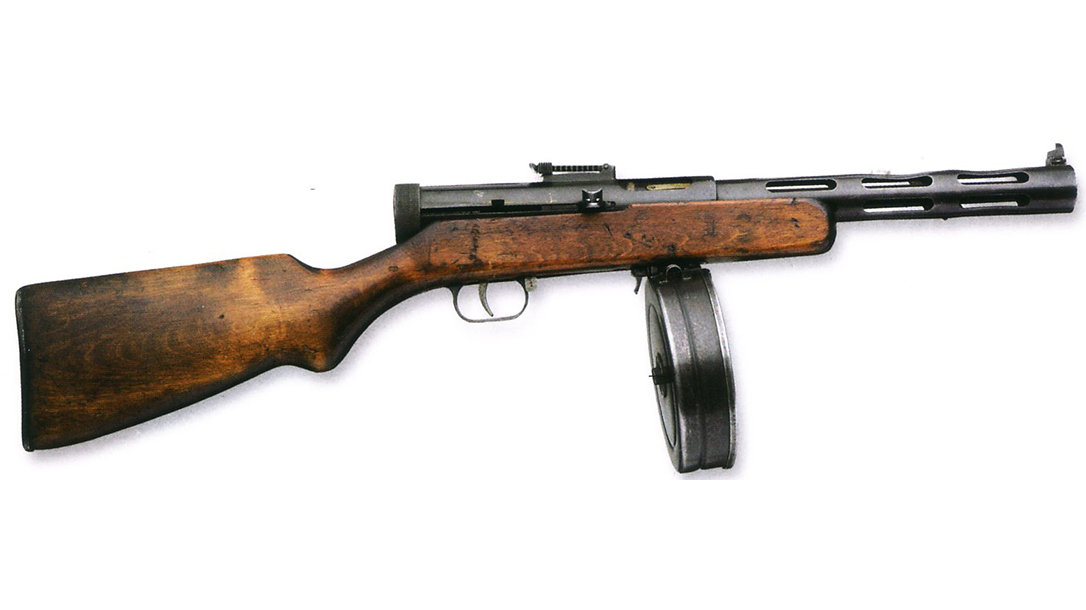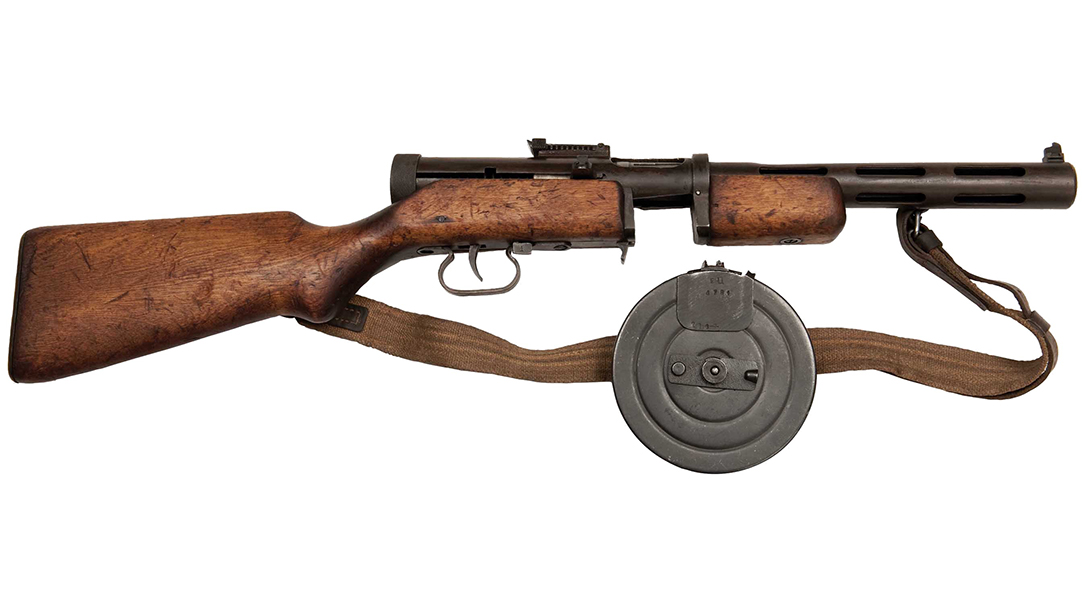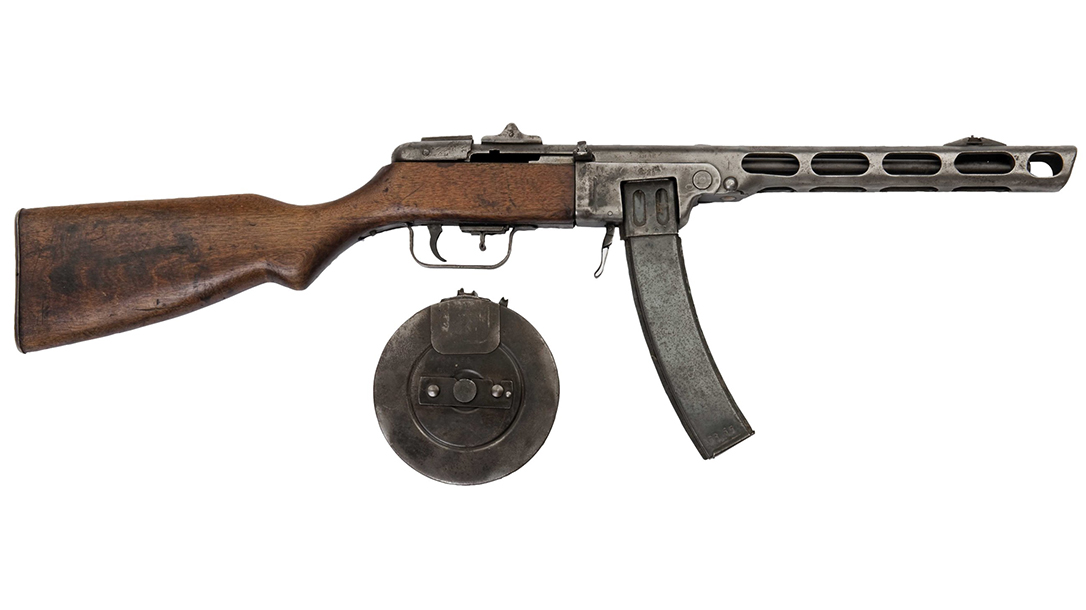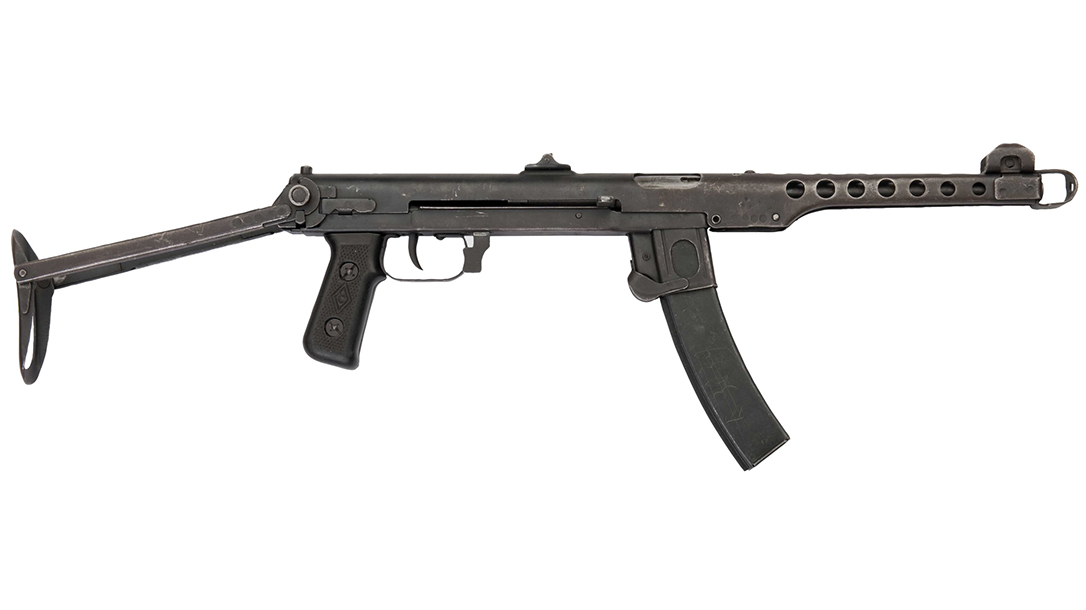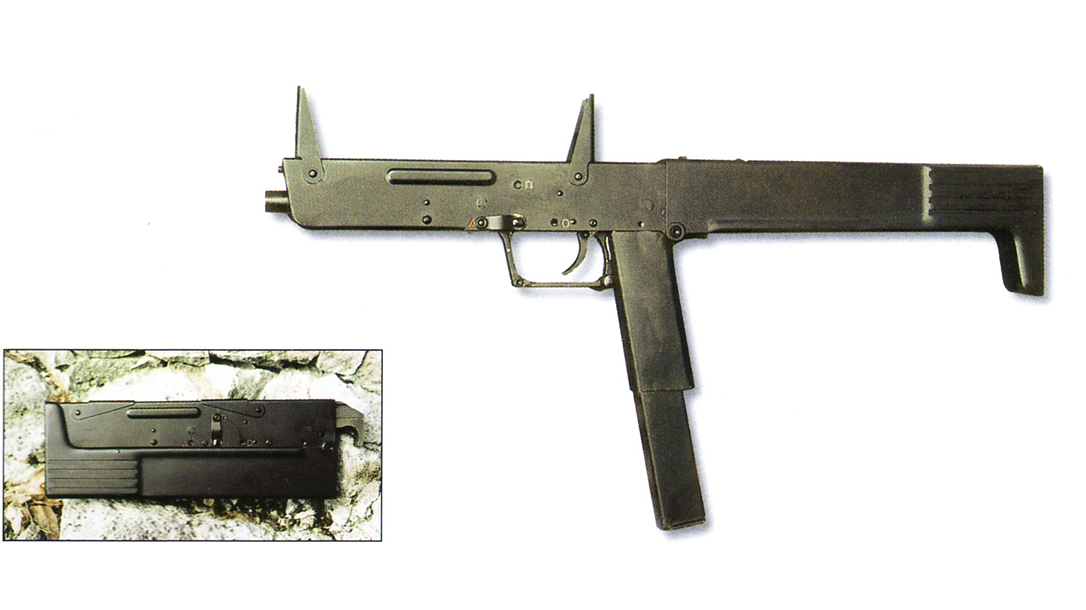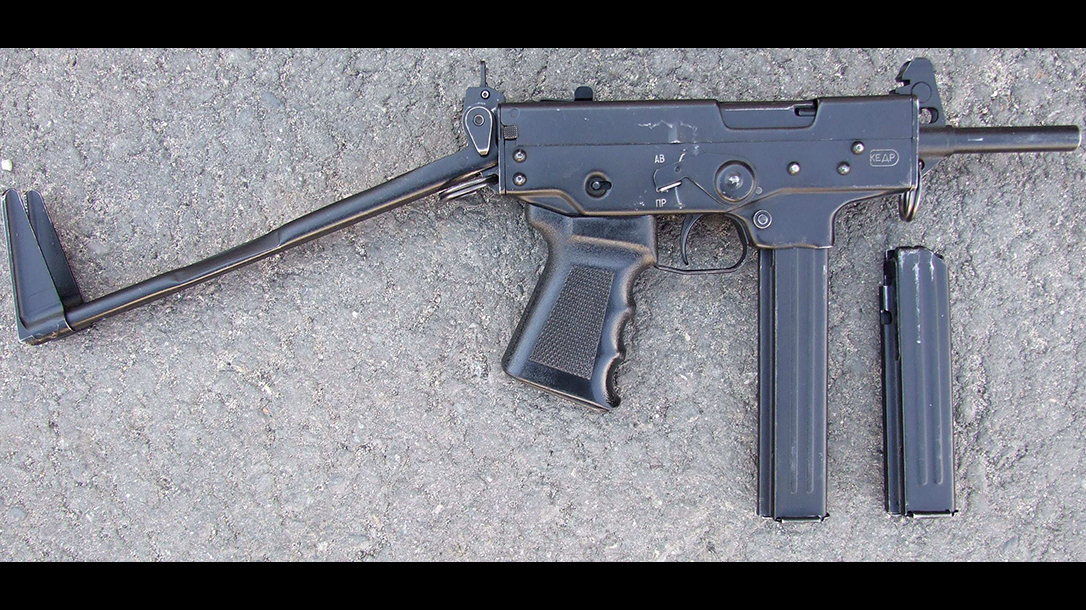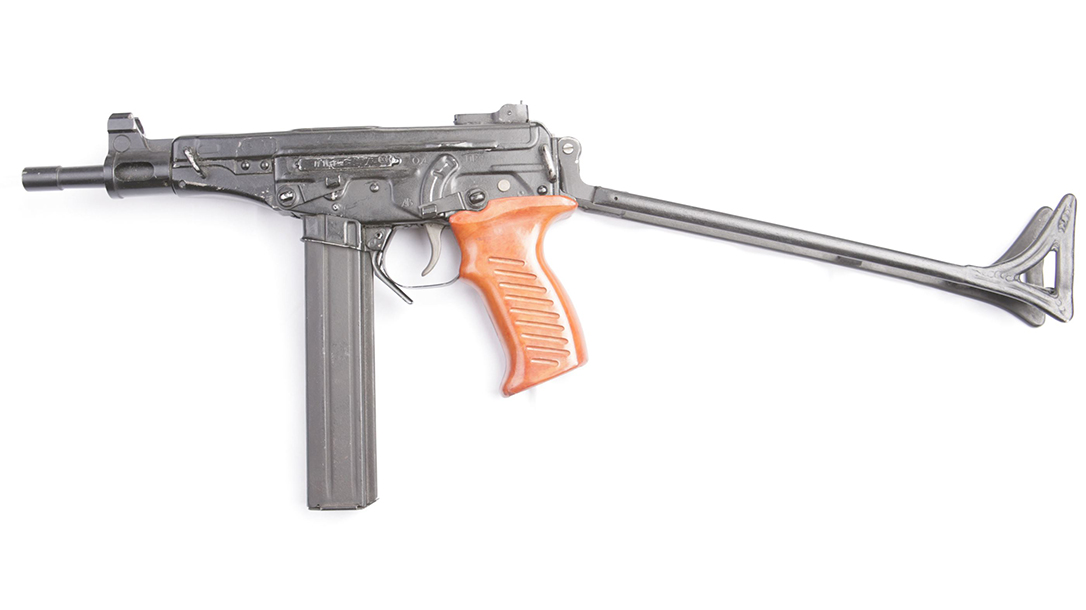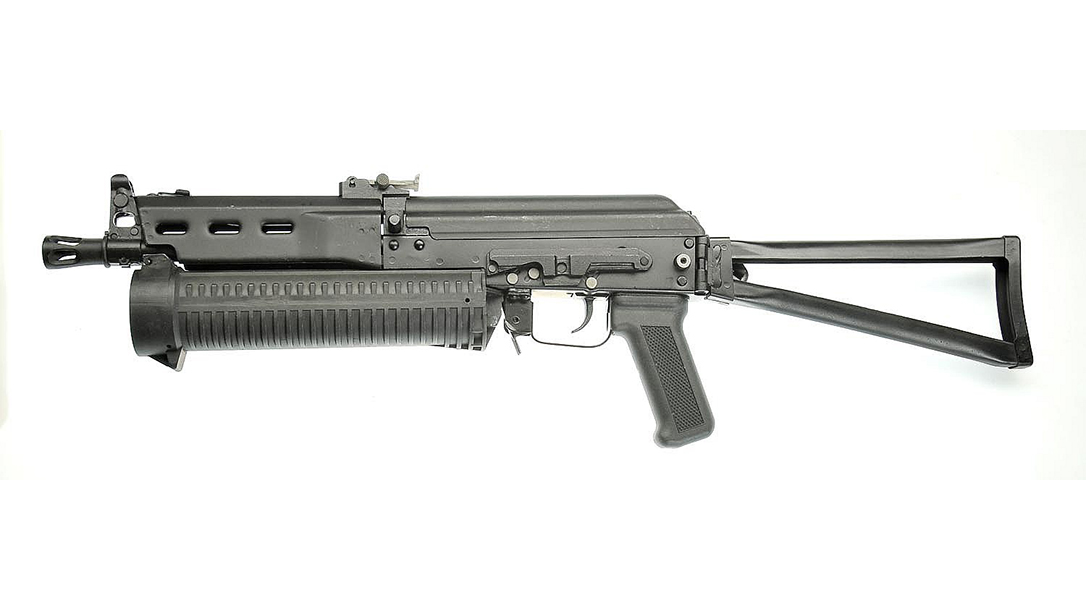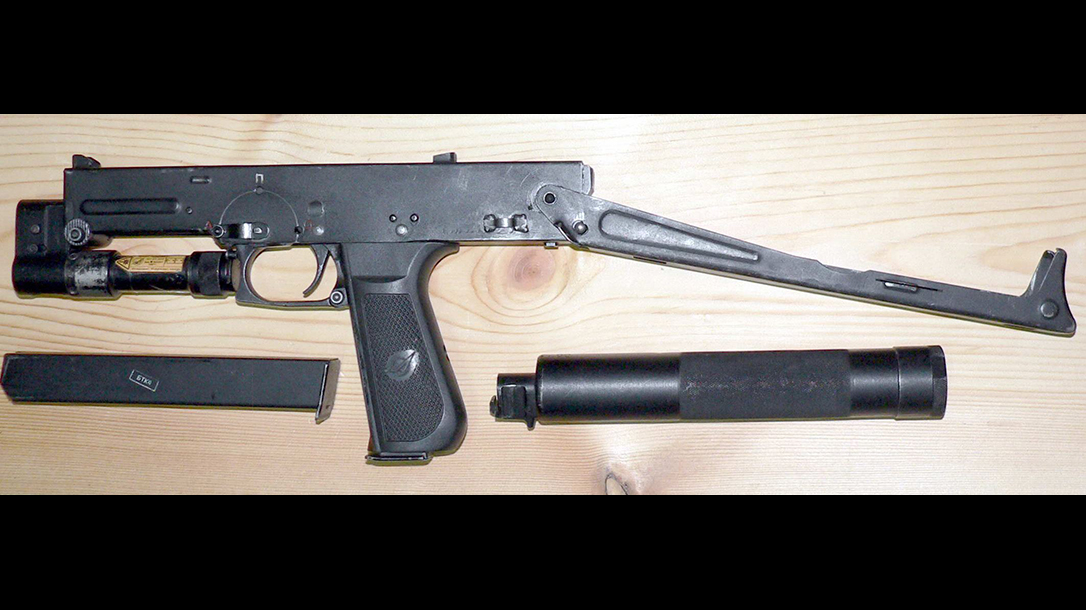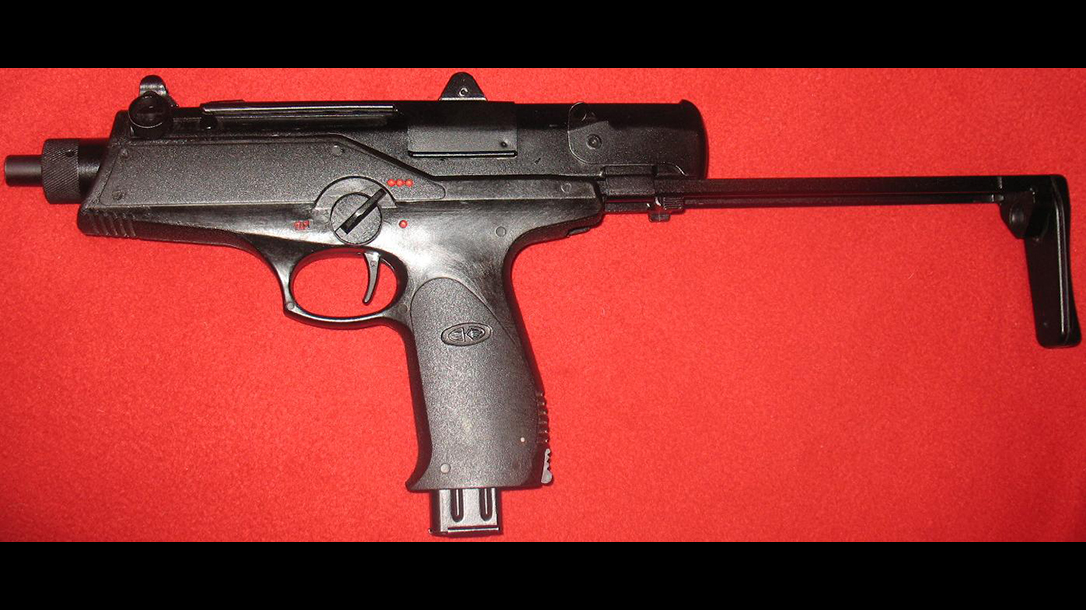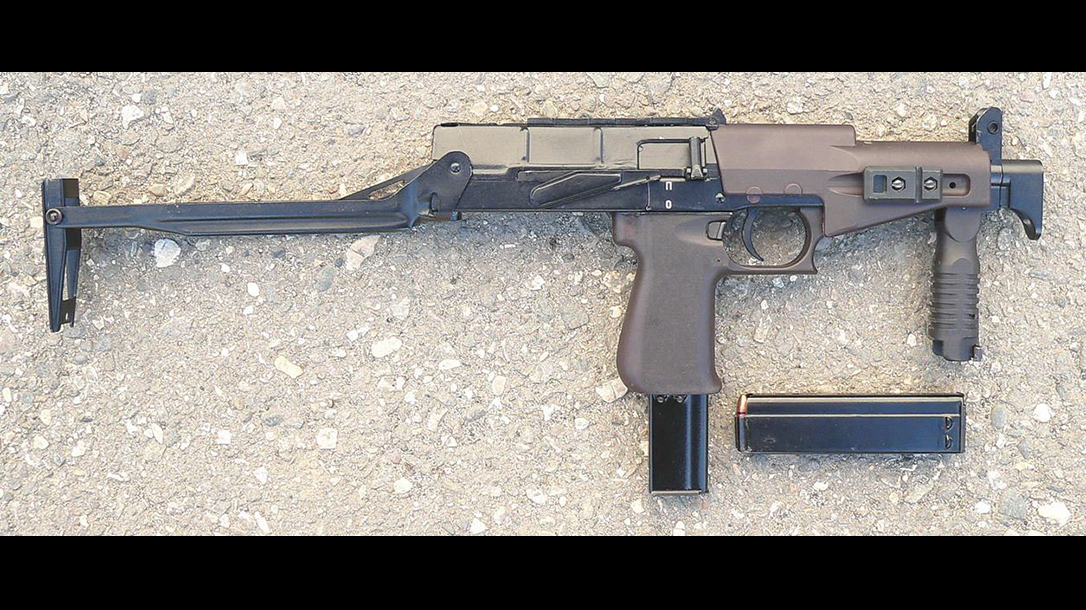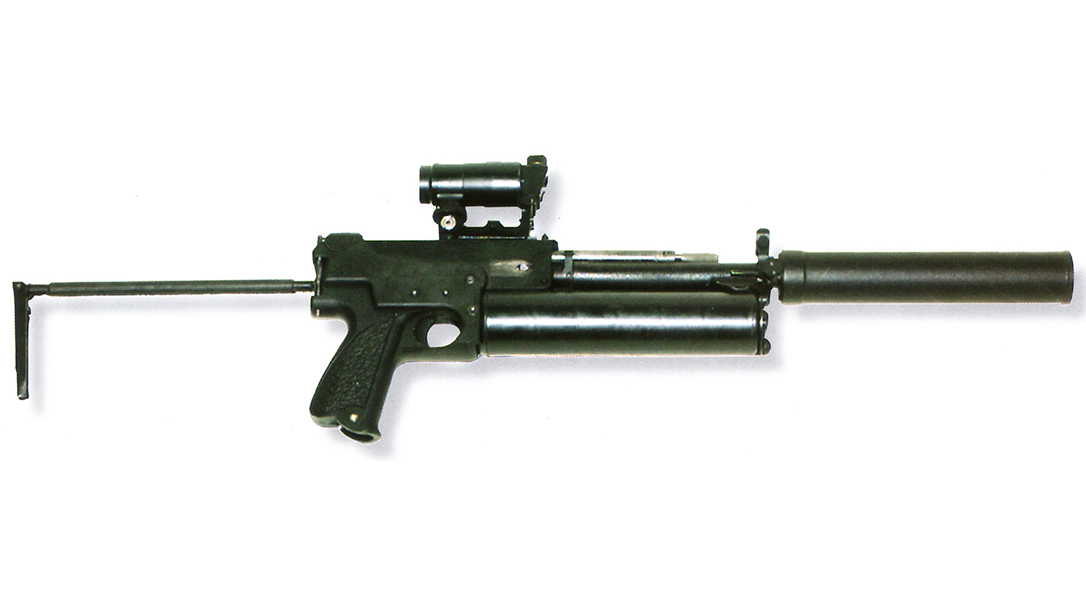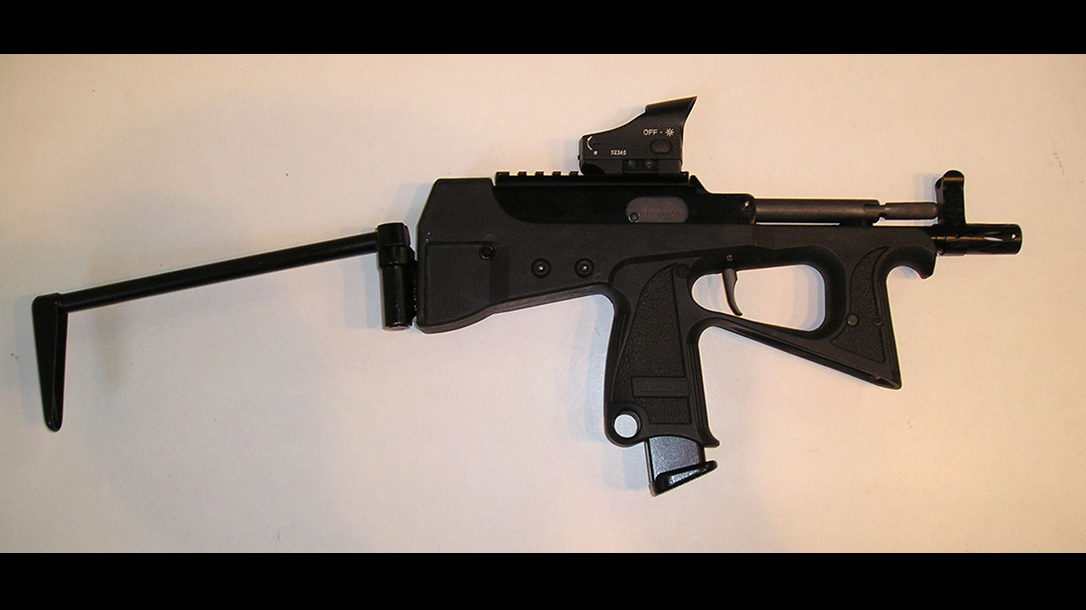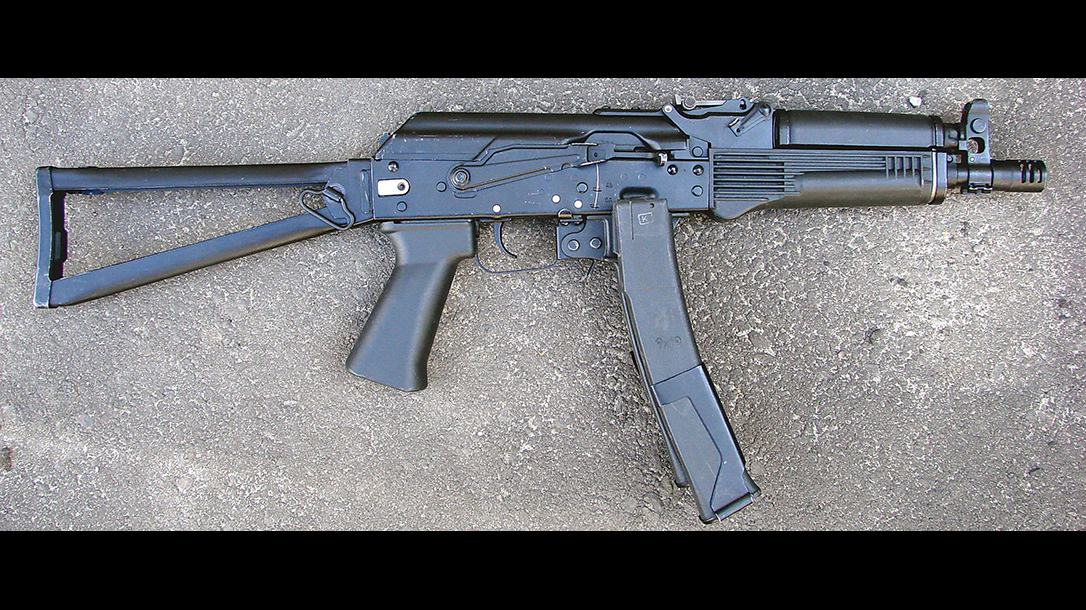Fedor Tokarev, one of the most successful Soviet small-arms designers of the pre-WWII era, began developing the first Soviet submachine gun in 1926. Unveiled in 1927, his first design was in line with contemporary foreign submachine guns except for the chambering. Because the Red Army hadn’t yet standardized pistol ammunition, Tokarev chambered his gun for 7.62mm Nagant revolver ammunition, slightly modified (squeezed at the neck) to provide more reliable feeding. The gun was fed from a detachable box magazine with a 21-round capacity. It had a carbine-type wooden stock and dual triggers for semi- and full-auto fire. Official testing of the Tokarev submachine gun began in late 1927, with generally positive results.
The second submachine gun of Soviet design appeared in 1929. Developed by Vasily Degtyaryov, it bore some resemblance to his new light machine gun, the DP-27. The Degtyaryov subgun used a top-mounted pan magazine that was bulky but well suited for feeding rimmed 7.62mm Nagant ammunition. It also used a delayed-blowback action.
Advertisement — Continue Reading Below
Pre-WWII Submachine Guns
In 1930, the Red Army finally standardized the slightly modified 7.63x25mm Mauser as its official ammunition for pistols and submachine guns. One critical reason for choosing the 7.63x25mm Mauser was its popularity thanks to previous purchases of German-made Mauser C96 pistols in that caliber. More importantly, the round was similar in diameter to the infantry rifle caliber, allowing the same barrel-making equipment to work for pistols, subguns and rifles. That allowed for significant savings on equipment and let workers remanufacture rejected rifle barrels into handgun barrels.
PPD-34/38
Between 1932 and 1933, the Red Army tested more than a dozen new 7.62x35mm submachine guns. Early in 1934, the Trials Commission recommended the new Degtyaryov, and in mid-1935, it was officially adopted by the Red Army as the Pistolet-Pulemyot Degtyaryova (PPD) of 1934. Furthermore, it was intended for arming officers and non-commissioned officers. Its production was fairly limited. After initial field experience, the design was slightly revised in 1938 to become the PPD-34/38. Limited numbers were also procured for the border guard troops of the NKVD.
The PPD was a sound design, but its adoption met serious resistance from top brass who envisioned newly developed full-power, self-loading rifles as the future for Red Army infantry and considered submachine guns to be police or even gangster guns. After internal political struggles, early in 1939, all submachine guns were recalled from active Red Army units and put into storage. Production was also stopped, but not for long. The Winter War between the Soviet Union and Finland, which started in late 1939 because of a territorial dispute, brought a big surprise to Red Army commanders. The Finnish Army fought with fierce strength and courage, and for the first time, the Red Army discovered the military usefulness of submachine guns, as its troops were on the receiving end of the Finnish Suomi guns.
Advertisement — Continue Reading Below
PPD-40
The change in attitude toward submachine guns was almost instant. Executive orders for resuming mass production of the PPD were issued in late December 1939. Consequently in January 1940, the PPD was officially adopted as a standard infantry weapon for the Red Army. To better match its Finnish rival, Degtyaryov copied the Suomi’s 71-round drum and modified it for the PPD-34/38. Several months later, the PPD was further updated with changes in the stock, magazine housing and drum magazine to become the PPD-40.
PPSh-41
However, despite its merits, the PPD had several shortcomings. It was expensive to manufacture and somewhat complicated in design. Recognizing those shortcomings, Georgy Shpagin began developing a simpler and less expensive weapon in early 1940. This new weapon was officially adopted for Red Army service in December 1940 as the Pistolet-Pulemyot Shpagina (PPSh) of 1941.
In late 1941, the Red Army requested development of a more compact weapon with a folding stock for tank crews and other military personnel for whom the wood-stocked PPSh-41 was too bulky. Other requirements included less weight and a reduced cyclic rate of fire of 400 to 500 rounds per minute. Several designers submitted prototype weapons to the new trials that began in February 1942. By mid-July of that year, the prototype designed by Alexei Sudayev was selected as the best weapon overall. It was simple, reliable and controllable when fired.
Advertisement — Continue Reading Below
PPS-42 & 43
The Sudayev was superior to the PPSh-41 in many respects. It was noticeably less expensive to make, much more controllable because of its lower rate of fire, and lighter and more comfortable to carry. Production of the new weapon, officially adopted as the Pistolet-Pulemyot Sudayeva (PPS) of 1942, began in late 1942 in besieged Leningrad. Early experience with the manufacture and use of the new weapon resulted in an improved version, the PPS-43, which was adopted in 1943.
Despite its obvious merits, the PPS-43 never replaced the older PPSh-41 in the hands of Red Army soldiers. That’s mainly because the need for more weapons was so great that there was no time to stop production of the older gun to retool factories for the new, potentially less expensive and more effective weapon. As a result, production orders for the PPS-43 were issued mostly to non-specialized factories, and it was manufactured in noticeably smaller numbers than the PPSh-41. The latter was produced throughout the war and became one of the most important small arms in Red Army stocks. Overall, almost 6 million PPSh-41s were manufactured during the war.
Changing Tides
Towards the end of WWII, the Soviets decided to change course after examining the American M1 Carbine and German StG 44. The new Soviet infantry small-arms concept called for a family of weapons firing intermediate-power ammunition. The new assault rifles were especially intended to replace submachine guns, retaining a roughly similar size and weight but providing a longer effective range and better lethality. Starting in late 1943, when the first samples of the new 7.62x41mm ammunition became available, almost all Soviet small-arms designers who had previously worked on submachine guns set out to develop more potent weapons.
Advertisement — Continue Reading Below
There were no noticeable Soviet submachine gun developments until the late 1960s, when it was decided to make domestic equivalents of foreign weapons like the Czechoslovak Vz. 61 Skorpion, Polish PM-63 and American MAC-10. Between 1970 and 1971, three prototypes were submitted for trials under the provisional designation of PP-71. In military tests, all of them performed adequately in reliability and durability but failed to meet expectations at 200 meters—too far for subcompact weapons firing the relatively low-powered 9x18mm ammunition. As a result, the requirements were dropped, and the prototypes forgotten—at least for a while.
PP-91 KEDR & OTs-02 Kiparis
Things began to change during the late 1980s and early 1990s, when the Soviet Union collapsed. The newly independent Russia resurrected two of the aforementioned PP-71 designs that had been gathering dust since the early 1970s. The Dragunov weapon, slightly modified, was approved for Ministry of Internal Affairs (MVD) use in 1991 and entered production in 1993 as the PP-91 KEDR. The Afanasyev gun entered production and service as OTs-02 Kiparis. Both weapons are chambered for the still-standard 9x18mm and are still used by various law enforcement organizations across Russia.
PP-90 & PP-93
The early 1990s also saw the development of several new weapons intended primarily for law enforcement use. The first was the folding PP-90, developed by the KBP design bureau in Tula. It was intended to be used by plainclothes security and law enforcement personnel, but it turned out to be problematic in terms of ergonomics and safety, and its practical use was fairly limited. A second weapon from KBP, the PP-93, proved to be somewhat more successful. It was basically a conventional 9x18mm weapon capable of mounting a suppressor and a laser-aiming module. It’s still used by various law enforcement units in Russia.
Advertisement — Continue Reading Below
PP-19 Bizon & AEK-919K
The mid-1990s saw the appearance of several other designs, such as the Izhevsk-made PP-19 Bizon and Kovrov-made AEK-919K. First appearing in 1993, the Bizon combined a high-capacity helical magazine with a more conventional layout. The gun was actually based on the AKS-74U with a shortened receiver, pistol grip, trigger unit and folding stock. In addition, the large-capacity magazine is under the barrel and serves as a forearm, resulting in a comfortable hold and trim profile. It also has standard AK-style controls. Initially produced for 9x18mm ammunition, the Bizon later appeared in 9x19mm, mostly for export.
The AEK-919K’s initial design was based on the Austrian Steyr MPi 69. After initial testing, the design was improved. The crossbolt safety was replaced by a rotating safety selector, and the overall length was shortened. The resulting gun was put into limited production.
SR-2 Veresk
Beginning in the late 1980s, the Russian military began looking for a pistol round more potent than the 9x18mm. This program, which culminated in 2000 with the adoption of a +P+ version of standard 9x19mm ammunition loaded with armor-piercing (AP) bullets and several new pistols to fire it, also produced two alternative rounds: the so-called 9x18mm “PM Modified” (PMM), which was built using a standard 9x18mm case with a hotter loading and a lighter bullet, and the new 9x21mm RG-054. The service life of the 9x18mm PMM was relatively brief because of the obvious dangers of using the higher-pressure rounds in old guns.
Advertisement — Continue Reading Below
The 9x21mm ammunition, which was initially dropped from the military trials, was later picked up and sponsored by the Russian FSB (Federal Security Service), which eventually adopted the caliber along with the powerful SR-1 Vector pistol, developed by the TSNII TochMash research institute. Later, that organization also developed a submachine gun for the round. To ensure reliable functioning with high-pressure ammunition, the new SR-2 Veresk subgun was designed with a gas-operated, locked-breech, rotary-bolt action. It fires from a closed bolt for enhanced first-shot accuracy. Originally intended for elite FSB and FSO (Executive Protection Service) units, the modified SR-2M is also in limited use by several SWAT-like units across Russia.
PP-90M1
The official adoption of 9x19mm ammunition as the standard handgun caliber for the Russian military and police also resulted in several new weapons. The first is the PP-90M1, designed during the late 1990s and early 2000s by KBP. It’s not known why it was assigned such a confusing designation, as it bears almost no relation to the 9x18mm PP-90/PP-90M folding gun also designed by KBP. The PP-90M1 was designed for police and Spetsnaz use in CQB scenarios, to compete in that role with the 5.45x39mm AKS-74U and PP-19 Bizon.
Advertisement — Continue Reading Below
Originally, it was offered in a dual, convertible-feed configuration using a helical drum magazine with a 64-round capacity or a 32-round box magazine with a special adapter. Production versions dispensed with the box magazine adaptors and are now also offered only with helical magazines. So far, only limited sales of the PP-90M1 have been reported, mostly to former Soviet republics such as Belarus and Kazakhstan.
PP-2000 & PP-19-01 Vityaz
At about the same time, KBP also developed the PP-2000. Designed to handle hot-loaded 9x19mm AP ammunition, the gun can also fire all standard ammo types in the same caliber. It’s configured with the magazine seating in the grip, and early prototypes were designed so a spare magazine could be used as a rudimentary shoulder stock. Current production models of the PP-2000, now in use by various police units across Russia, are issued with more conventional (and slightly more comfortable) side-folding shoulder stocks.
Finally, after requests from elite counter-terrorism units, the Izhmash factory redesigned its PP-19 Bizon in 1994 to fire new 9x19mm service ammunition and use more conventional box magazines. The new weapon was designated as the PP-19-01 Vityaz. Unlike the Bizon, this weapon is now in full production and is widely used by various law-enforcement units across the country.
Advertisement — Continue Reading Below
This article was originally published in the 2018 issue of “AK-47 & Soviet Weapons.” To order a copy, visit outdoorgroupstore.com.
